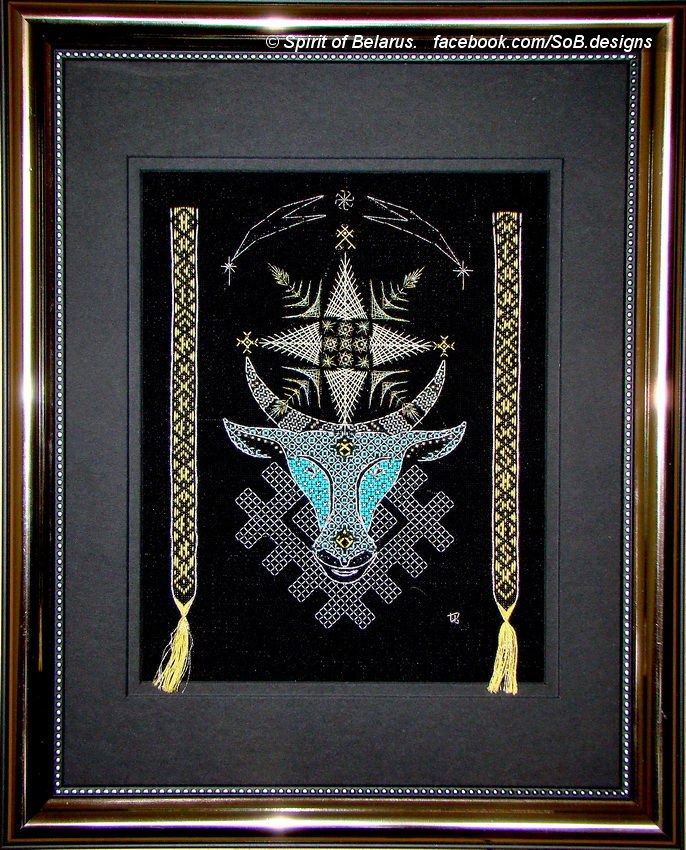



Theadworks 2016 Flashback
I have been very happy and proud that my works were a part of the Threadwork 2016 Show!
“Threadworks” is a special project of the Ontario Network of Needleworkers which showcases exceptional and creative needlework by artists from across Canada.
It is a juried exhibition which mandate is to mount, every three years, a travelling show to a number of museums and galleries across Ontario during the next two years.
The theme for the exhibit 2016 was “Flashback.”
I submitted two pieces – Kaliada Goat and Ripples-On-Water. The both of them were accepted to the show.
Ripples-On-Water is a reversible wall hanging made in Belarusan Nizanka.
I just wanted to show the best features of Nizanka.
Kaliada Goat is a design made in mixed techniques - Canvaswork, Blackwork, String Art, Gold Work, Beading. Threads used - cotton, silk, rayon, bamboo, metallic, beads.
It features combined traditional images of Kaliady Holiday still celebrated in Belarus, which I tell about below.
In Belarusan culture, the Goat is the sacred, magic animal who can easily make you success just by walking around your place.
The folklore says, "Where the goat walks, there rye grows. Where the goat horns, there is harvest growth".
So, it is worshiped during a winter holiday season, namely the Winter Solstice time, when an 'old' year comes to an end and a new one begins. In Belarusan language, this holiday is called 'Kaliady' (from the word 'kola' -- 'a circle'). It is a very funny time* when the groups of strange people in fancy dress go door-to-door, soliciting for food by singing carols and leading the magic “goat” around the master’s house in order for him to have a good harvest next year.
In my 'Kaliada Goat' design, there are several Belarusan sacred symbols connected to the winter holiday season -
the Goat itself,
Bethlehem Star which symbolizes Jesus' Birth (Christmas),
the geometrical sign of The Sun,
the signs of Ancestors,
the signs Wealth and Good-being,
on Goat's snout, is placed the sacred sign of Completion (Finishing),
and on Goat's forehead - the sign of Beginning (Appearing, Sprouting).
At the very top is the solar sign of the Kaliada itself.
*More about the Kaliady holiday is written for my Kaliada Star design here. And my essay is here.
At the right site of the design, there is a caption made in the Belarusan Traditional Stitching Motifs Font**. It is stitched in Belarusan Nizanka techniques and says, "Merry Christmas!".
At the left, the caption says, "Вясёлых Каляд!" which means "Merry Kaliady!" in Belarusan.
**The Belarusan Font is the modern invention based on traditional Belarusan stitching motifs. It is created by Belarusan philosopher Mihail Bayaryn. See it here.



























About Kaliada Hiliday in Belarus
While other Slavic cultures have Christian names for their common holidays, the Belarusans, however, stubbornly name their holidays by their ancient (pagan) way. Ester is Vialikdzen as ‘The Great Day’ and Saint Ivan (St.John the Baptist Day) steps aside for Koupalle as in the Summer Solstice Day. And so why should Christmas be any different? Belarusans call it “Kaliady”.
Patently, this name has no relation to Jesus’ birth. Although, Belarusans observe this significant event and praise it in their carols, but with this only action, the link between Kaliady and Christmas ends.
Kaliady is the pre-Christian celebration of the end of year and the beginning of the new one. It is believed the word “Kaliady” takes its root from word “kola” (wheel, circle) symbolizing the Sun, seasonal cycle and winter solstice. Later is was adopted for Christmas celebration by Orthodox and Catholic churches.
Celebrating this holiday people get together for frivolous fun and feisty frolics called “going kaliadying”. Belarusans are well known for their love of jokes and improvisation. During three weeks, people dressed up as animals and mythical beasts, wearing masks to hide their identities and to encourage great fun parade through their villages horsing around, playing games and acting plays. They go door-to-door singing carols to wish the hosts health, wealth and great harvest in the year ahead and beg for tasty treats. During this holiday, it’s customary to carry the Kaliada Star – a handmade, ornate, and large rotating beamed ring which symbolizes the Sun and seasonal cycle. Later it became symbolic of the Star of Bethlehem.





